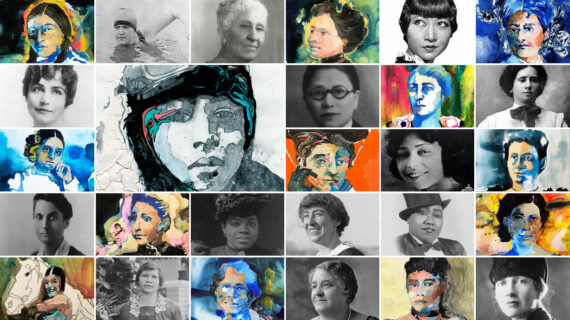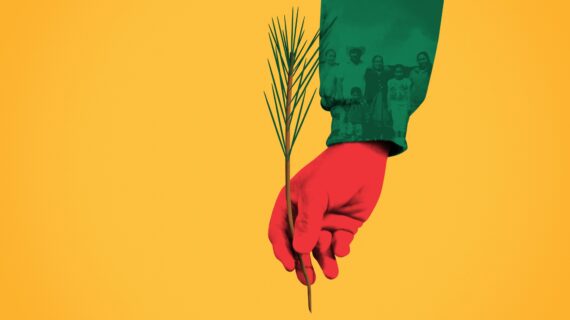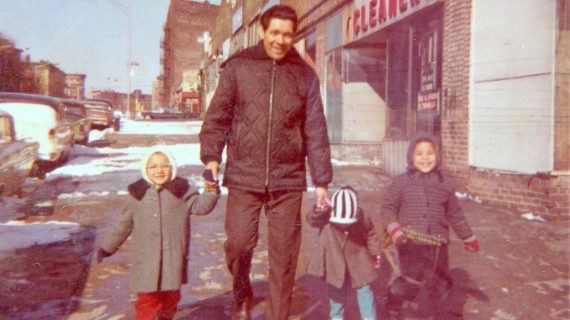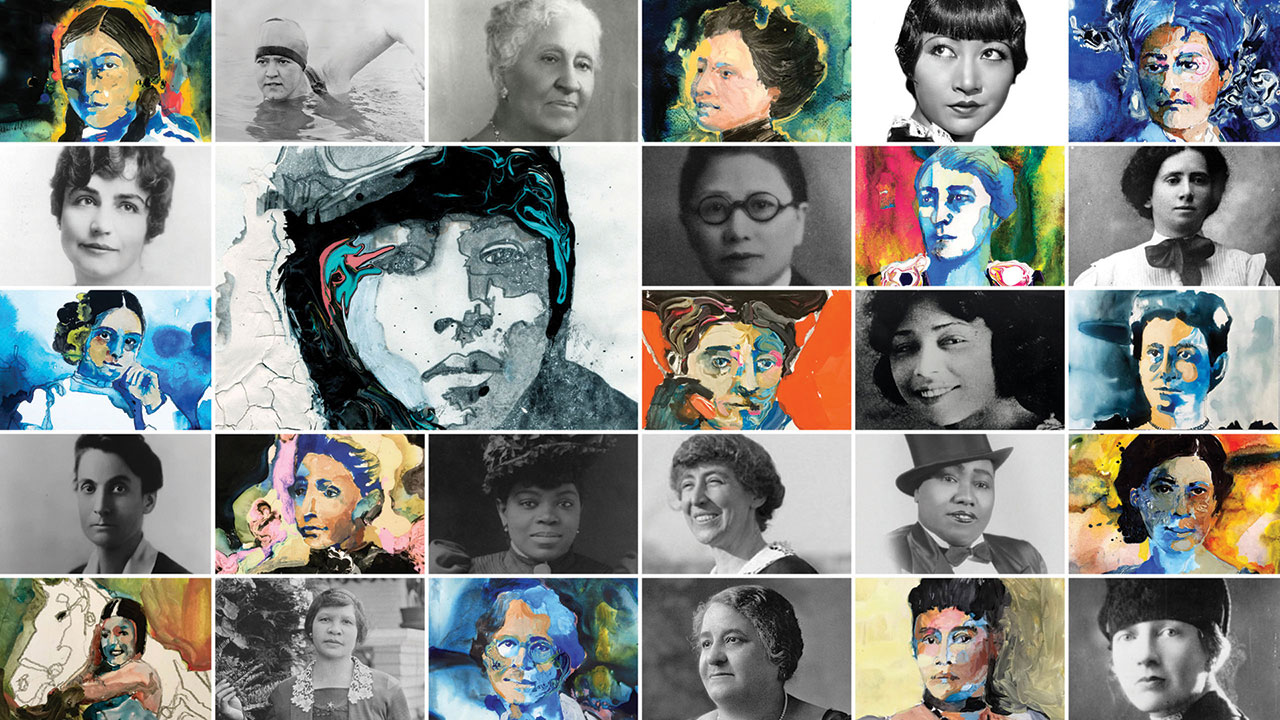– Thank you guys for coming tonight. Welcome to our program celebrating the 100th anniversary of the 19th Amendment. We’re happy to have Bob Kann back here at the library. He is an author, a historian and an entertainer, all rolled into one. It might seem incredible that there was a point in our history when women could not participate in this experiment in democracy, but it has only been in the past 100 years that all of the females in this room could literally go into the polls and cast their vote for public office in this country. And so, celebrating this anniversary, I thought was a really important thing to do, and Bob is here to share with us the stories of Carrie Catt, Belle La Follette, and other women and individuals who helped to bring about the 19th Amendment and Wisconsin’s role in that process. So welcome, Bob.
– Thank you. [applauding] Thank you, good evening. In July 1848, teenage Charlotte Woodward read about a women’s rights convention that would soon meet in Seneca Falls, New York, about 40 miles from her home.
At the time, Charlotte unhappily worked at home selling gloves. She later said, “I do not believe there was “any community anywhere in which the souls of some women “were not beating their wings in rebellion. “Every fiber of my being rebelled, although silently, “for all the hours that I sat and sewed gloves “for a miserable pittance which, after it was earned, “could never be mine. “I wanted to work, but I wanted to choose my task “and I wanted to collect my wages. ” Charlotte, and several of her friends, decided they must attend the convention. The country girls rode to Seneca Falls in a horse-drawn wagon, traveling further than almost any of the other attendees. This was the very first women’s rights convention. It launched one of the pivotal battles in American history. The struggle for the most fundamental right in American democracy, the right to vote. Approximately 260 women and 40 men attended, but only 68 women and 32 men signed the Declaration of Sentiments, the document outlining the rights they insisted women were entitled to as citizens of the United States.
72 years later, when the 19th Amendment to the United States Constitution finally passed, Charlotte Woodward Pierce was the only signatory of the Declaration of Sentiments who was still alive. The Seneca Falls Convention passed 12 resolutions related to women’s rights, including equal access to job opportunities, education and the right to control one’s own money. The only resolution that did not pass unanimously was the right to vote. Some considered it too controversial and feared that it would compromise their ability to win equal rights in other areas. Even conference organizer Lucretia Mott, feared that demanding the vote would cause the movement to be ridiculed. But fellow organizer Elizabeth Cady Stanton, persisted and refused to back down. She said, “I saw clearly that the power to vote “was the right through which all other rights “could be secured. ” The Seneca Falls Convention was indeed ridiculed for proclaiming a woman’s right to vote, and several backers of women’s right withdrew their support. Nevertheless, this event marked the beginning of the woman’s suffrage movement in the United States. Given the enormous obstacles they faced, it is miraculous that women ever gained the vote.
In 1848, in a country dominated by men and a culture dominated by men, women were considered weak, incapable of complex thinking, and controlled by their emotions. Men were considered strong, complex thinkers, and in control of their emotions. Abusive husbands were not punished for beating their wives. Fathers automatically retained custody in divorce proceedings, and women could neither testify, nor bring legal suit to court. For more than 70 years after the Seneca Falls Convention, thousands of suffragists faced public ridicule, imprisonment, and violent opposition as they petitioned, marched, and demanded their simple rights as citizens. The achievement of suffrage was a complicated process, involving several generations of women, and many different individuals, and groups, with varying agendas. Some were idealistic and inclusive, many were openly prejudiced and exclusive, and most were driven by a combination of motives and beliefs. Some women fought for the vote because there was a matter of simple justice. They argued that, as human beings, they were entitled to the vote, and they should not be denied their vote. They were citizens just like men.
Their participation would make democracy more authentic. Conversely, other women fought for the vote because they argued that women were different and more moral than men. Voting women would be more sensitive to the plight of the weak and vulnerable, and they would reduce corruption in politics. Some special interest groups fought for the vote to support their own causes. Some women of the labor movement fought for the vote as a partial solution to low wages, sexual harassment in the workplace, and dangerous work conditions. Some African American women fought for the vote as part of a broad agenda to try and obtain civil rights for black men and black women. Pervasive racism complicated their activism, but nevertheless, African American women fought for the vote with or without a connection to white women suffrage organizations. Because of these varying agendas, the women’s suffrage movement never shared a single mindset, nor unified into a single coalition, but, instead, it operated as a fluid movement of sometimes conflicting alliances. Some women in the suffrage movement would have willingly excluded other women from gaining the vote to gain their own enfranchisement. Nevertheless, their parallel activism was critical to their ultimate success.
With little hope for reform in the state and federal legislatures, the only recourse left for women was to campaign in the court of public opinion. And there was no roadmap for how to conduct such a campaign. They began in 1848, with no conception whatsoever for how to mobilize thousands of women and men in a campaign that would require effective public speakers, journalists who could report on suffrage news, strategically astute leaders, and much more. They would succeed, but nothing came easily. Take public speaking. A woman speaking for the suffrage movement faced very real dangers, because she would have to cross the boundary of acceptable female public behavior and overcome the taboo against women speaking in public. And she would have to learn how to speak from the platform, on street corners, from the back of cars, in debates, and many other venues, to often hostile, and sometimes violent, audiences of men. The growth of the early suffrage movement came to a grinding halt in 1861 when the nation was torn apart by the Civil War. Some suffragists argued they should continue to lobby for the vote, but most deemed the war so important that it superseded their efforts to win the vote for women. Instead, most directed their efforts toward ending slavery, with the expectation that once the war was won, men would grant the vote to women because of their support for the war effort.
When the war did end, the suffrage movement split, between those who believed black men needed the vote, even more than women, and those unwilling to postpone their efforts to win the vote for women for the sake of lobbying for black men to get the vote. In any case, in 1868, the 14th Amendment to the Constitution passed, confirming that black men were citizens and guaranteeing them equal protection under the law. There was no mention of women. In 1869, the 15th Amendment to the Constitution passed, prohibiting governments from denying citizens the right to vote because of race, color, or previous servitude. And again, there was no provision addressing discrimination against women. In 1870, the suffrage movement split once again. This time into two organizations. Elizabeth Cady Stanton and Susan B. Anthony founded the National Woman Suffrage Association. They would work to get a federal suffrage amendment passed as part of a broad agenda of women’s rights issues.
Men were not allowed in the organization. Lucy Stone and Henry Browne Blackwell founded the American Woman Suffrage Association. They would work in individual states to try and get suffrage laws passed. Men were welcome in the organization. While these two East Coast-based suffrage organizations were forming, women’s suffrage scored their first victories in the West. At the time, state and territorial legislatures had the power to determine who could vote and what they could vote for, so tiny territorial legislatures had the power to enfranchise women. In Wyoming, all you needed was nine votes, a majority of the territorial legislature, and the signature of the governor to pass a law. So in 1869, Wyoming passed the first universal suffrage law for women. Why was Wyoming first? Well, perhaps because there were so few women in Wyoming. With a population of about 6,000 men and only 1,000 women.
Perhaps Wyoming enfranchised their women as a way to attract more women to this female-starved territory. And some men figured that since there would still be so few women, their votes wouldn’t matter anyway. The main sponsor of the bill, saloon keeper Harry Bright, said he supported suffrage because, quote, “My wife is as good as any man “and better than convicts and idiots!” [audience laughing] In 1870, Utah enfranchised their women in a move largely tied to Mormon settlers’ desire to preserve polygamy, which was under attack by anti-polygamy congressmen. At the time, polygamy was common amongst Mormons. And the Mormon population was growing. Anti-polygamy congressmen figured that by enfranchising Utah women, they would vote against polygamy and that would be the end of it. But Mormon elders knew that Utah women, in fact, supported polygamy. By enfranchising Utah women, it would shed their image as being oppressed and it would stem the anti-polygamy tide in Congress, so Utah’s territorial legislature enfranchised their women. During the 1870s and 1880s, the most dominant issue for reform-minded women was not women suffrage, but temperance, the movement to outlaw alcohol. After the end of the Civil War, the rise of alcoholism and related damage to families led to the growth of the temperance movement.
In the long run, the temperance movement both helped and hindered the suffrage movement. It did train a generation of women to fight for what they believed, and gave them experience organizing for change. Many leaders of the suffrage movement first worked in the temperance movement, and then they applied their talents toward gaining the ballot for women. However, the growth of the temperance movement also fueled fierce opposition from the powerful liquor industry, which feared that if women gained the vote, they would vote to prohibit alcohol. By 1890, the two East Coast-based suffrage organizations recognized they were ineffective and their squabbles were hurting the cause. They patched their differences and merged to form the National American Woman Suffrage Association. Or NAWSA, as it became known as. They would work both to get a federal suffrage amendment passed, and they would work in individual states to try and get suffrage laws passed. Elizabeth Cady Stanton was the organization’s first president. She was succeed by Susan B.
Anthony, and then Carrie Catt became Susan B. Anthony’s chosen heir. In 1893, Colorado enfranchised their women in a movement that happened as part of a popular referendum. Because it was a referendum, Colorado suffragists had to convince a majority of the men in the state, not just a handful of legislators, to agree to share their power with women. I believe the referendum passed in Colorado for three primary reasons. First, at the beginning of 1893, a new party, the Populous Party, rose to power in Colorado. The Populous believed in equality for all, and enfranchising women would expand the size of their electorate. Second, many pro-suffrage women in Colorado were active in the Colorado labor movement, farm movement, temperance movement, and women’s club movement. These women faced a loose reform-based coalition, which in combination with endorsements from the Populous Party, led to victory. And finally, because Colorado had such a small state suffrage organization, they asked NAWSA, the national suffrage organization, to provide assistance, and NAWSA sent Carrie Catt to help.
Carrie Catt was born in Ripon, Wisconsin. She was an experienced organizer who galvanized the Colorado suffrage movement, traveled around the state during the last three months of the referendum, leading the movement to victory, and in the process, ensuring that she developed the reputation as NAWSA’s top organizer. In 1896, Idaho enfranchised their women. Again, through a loose-based coalition of reform-minded women. During the next 14 years, there would be no new states that enfranchised their women. During these years, the women’s club movement exploded throughout the United States. Initially, women’s clubs were formed to provide social contact and intellectual stimulation for their mostly middle class members. Eventually, though, these women expanded their influence outside of the home by establishing kindergartens, playgrounds, libraries, hospitals, and much more. Over time, they became frustrated by the limits of reform without possessing the ballot. So, with the confidence and skills they acquired winning municipal reform battles, they turned their attention toward winning the vote for women.
While the women’s club movement expanded, Carrie Catt’s reputation soared, leading to her election as the president of NAWSA from 1900 til 1904. When Catt assumed the presidency of NAWSA, she was appalled by the state of disorganization she found. Under the leadership of Susan B. Anthony, the chief activity of suffragists was agitation, not organization. Catt concluded that to win the vote, the organization needed to be filled with reform-minded women, they had to be highly structured, and they had to be willing to work in a highly disciplined fashion. This organizational remake wouldn’t be completed until her second term of office from 1915 until 1920, when she would transform a disorganized group of women into a powerful and purposeful organization. Although I believe Carrie Catt was one of the women most responsible for women ultimately winning the vote, my great admiration for her is tempered by my disgust with her racial prejudice and the prejudicial policies established under her leadership. Catt believed that African Americans were a stain on the face of democracy because they were illiterate voters who were easily manipulated. Catt concluded that suffrage would gain no traction in the South because white men in the South generally did not believe women should vote at all, and they found it particularly repugnant to consider to give the vote to black women. And so, Catt made a calculated political decision that ultimately pandered to racism.
In 1903 under Catt’s leadership, NAWSA established a separate, but equal, membership policy. At the NAWSA Convention in New Orleans, in 1903, black women were excluded from attending the convention. At that convention, NAWSA’s executive body issued a statement endorsing the policy of states’ rights, which meant that, within NAWSA, each state association would have the power to establish its own policies, which the executive body knew meant the southern state associations members– the southern state associations would establish prejudicial policies toward blacks. In contrast to Carrie Catt, Wisconsin’s Belle La Follette was a suffragist who fought against racial discrimination her entire life. Belle was an experienced politician, having served as her husband Bob’s campaign manager, political advisor, and speech writer in his successful campaigns for Congress, Senate, and governor. After Belle died in 1931, The New York Times wrote that she was probably the best known, yet most influential of all American women who have had to do with public affairs. In 1909, Belle and her husband, then Senator Bob La Follette, founded La Follette’s Weekly Magazine, which is still published today under the name The Progressive Magazine. In her column, Belle was the first woman who wrote consistently about women’s suffrage, international disarmament, and ending racial segregation. Belle had a national following and used her column to make the case for suffrage whenever possible. Widely respected, she was appointed to a leadership position within NAWSA.
Belle fought for racial equality her entire life, and she even personally complained to President Wilson after his administration had punished several black employees for violating the administration’s racial segregation policy. By 1910, it had been 14 years since any states had newly enfranchised their women. Many suffragists had just about given up on the state campaigns, so the victory in the state of Washington in 1910 revitalized the movement. The victory in Washington came about through another loose reform coalition of women involved in a variety of progressive organizations. In 1911, California enfranchised their women. The California women rejected the quiet, behind the scenes lobbying techniques of the national organization, NAWSA, and instead they boldly marched in parades, staged guerilla public speaking events, and launched an ambitious advertising campaign featuring banners, billboards, and leafleting. These audacious public displays for the time led the Los Angeles Times to describe these suffragists as, quote, “A gang of dynamiters. ” [audience laughing] The victories in Washington and California inspired other state campaigns, and by 1915, most women in the West could now vote. The 1912 presidential election catapulted the suffrage movement onto the national stage. During the summer of 1912, former President Teddy Roosevelt led an exodus from the Republican party and founded the Progressive Bull Moose Party.
With the election only a few months away, the Progressives needed an instant party structure, and the suffragists became one of their main partners. The suffrage movement had experience and resources useful to the Progressives, and suffrage fit well with the Progressives’ reform agenda. Now, for the first time, the suffrage movement was endorsed by a national party, and Roosevelt promised that if elected, he would appoint suffragist and pioneering social worker, Jane Adams, to his cabinet. Roosevelt wound up winning 27% of the vote. He succeeded in splitting the Republican vote, allowing Democrat Woodrow Wilson to assume the presidency with only 41% of the votes. Woodrow Wilson had tried avoiding the woman’s suffrage question throughout his entire political career. During the 1912 presidential election, he again side-stepped the issue, saying this wasn’t a national matter, this was a matter for states to decide, placing him safely within the states’ rights southern Democrats’ camp. Shortly after his election, however, he no longer could avoid the issue. On the day before his inauguration, Alice Paul, the new director of lobbying for NAWSA, staged the very first woman’s suffrage parade in Washington D. C.
When Wilson arrived in Washington on the day before his inauguration, he was surprised that there wasn’t a huge crowd to greet him. When he asked the staff, “Where are all the people?” they said, “Oh, they’re on Pennsylvania Avenue “attending the suffrage parade. ” The suffrage parade was led by labor lawyer Inez Milholland, dramatically dressed in white and mounted on that white stallion. The parade featured banners, floats, and 5,000 to 8,000 marchers, including notables Eleanor Roosevelt, Helen Keller, Nellie Bly, and Belle La Follette. The marchers were attacked by an angry mob of men, outraged by the sight of women demanding their rights in so public a fashion. The marchers were attacked by that mob, they were grabbed of the floats, thrown to the ground, their banners were smashed and snatched away from them. Over 200 women were treated for injuries in hospitals after the parade. Alice Paul became a national figure because of the publicity surrounding the parade. Paul gave the suffrage movement a unique combination of a woman with unshakable conviction, willing personal sacrifice, and remarkable political savvy. The parade and the attention it attracted were monumental in advancing the suffrage cause.
The parade also shed light on the racial prejudice characteristic of many of the white suffragist leaders, including Alice Paul. So, two months before the parade, in January 1913, Ida B. Wells-Barnett, an African American journalist, and pioneering civil rights activist, founded the Alpha Suffrage Club in Chicago, the city’s first suffrage club for black women. Wells-Barnett had fled to Chicago from Memphis several years earlier when a mob firebombed her office and threatened to kill her because of her relentless work on behalf of the anti-lynching movement. Wells-Barnett had reported on lynchings as no one had done before her, demonstrating the vast scope of the problem, and proving that lynchings in the South were primarily used to punish blacks whose businesses competed with whites. It was astoundingly courageous work. So, in March 1913, Wells-Barnett and other African American suffragists from Chicago went to Washington to march in the parade. But when they got there, Alice Paul told them they cannot march alongside the white members of the Illinois delegation, because Paul feared that a racially integrated delegation would alienate the southern suffragists. Wells-Barnett insisted that she and the other black suffragists march with the rest of the Illinois contingent and not at the back of the parade. Initially, Wells-Barnett left the scene, but as soon as the parade began, she simply ignored Alice Paul, slipped into the parade, and marched alongside the rest of the Illinois delegation.
Although Alice Paul’s attempt to segregate the parade was consistent with NAWSA policy, her militant tactics alienated the leadership of NAWSA, who found the parade to be, quote, “unladylike. ” This, and other differences of strategy, led Paul to leave NAWSA and form the Congressional Union For Woman Suffrage, which later became called the National Woman’s Party. This organization worked exclusively on getting a federal suffrage amendment passed, while NAWSA continued to primarily work in individual states to get suffrage laws passed. By 1915, the suffrage movement was in a state of crisis. There had been no progress made toward getting a federal suffrage amendment passed, and there were no states outside of the West that had passed universe– universal, tongue twister, universal suffrage laws. The command of NAWSA recognized that they needed a change of leadership, so they drafted Carrie Catt to assume the leadership of the organization once again. Catt proceeded to remake NAWSA into an organization of unmistakable power and effectiveness, mobilizing more than two million women in an organization that’s been described as the most powerful women’s organization in history. Toward the end of 1915, NAWSA changed their tactics so that they, too, now would focus primarily on getting a federal suffrage amendment passed, now only working in individual states where victory seemed achievable. Also toward the end of 1915, President Wilson announced that he would be voting as a private citizen in the New Jersey state suffrage referendum, and he would be voting in favor of woman suffrage. During his first term of office, Wilson kept track of the shifting political winds regarding the woman’s suffrage question.
The number of congressmen and senators from the states in which women could vote was now growing. Four million women could now vote for or against him in the 1916 presidential campaign, and that could not be ignored. Wilson’s decision to endorse women’s suffrage, albeit on a state by state basis, was part of his reelection strategy to try and win the votes of pro-suffrage advocates, and win back the votes of disenchanted voters alienated by some of his first-term policies. In the 1916 presidential campaign, Wilson’s Democratic party endorsed women’s suffrage, but on a state by state basis. The Republican party endorsed a federal suffrage amendment. The women’s suffrage movement was now a player and a force on the national political scene. Wilson narrowly won reelection. Some historians attribute his victory to the votes by women, with Wilson winning in 10 of the 12 states in which women could vote. Shortly after his reelection, on January the 10th, 1917, the National Woman’s Party staged the very first picketing of the White House. The picketers were silent sentinels.
Instead of shouting out their demands, they wrote them on banners, saying, “Mr. President, what will you do for woman’s suffrage?” “Mr. President, how long must women wait for liberty?” The latter was the final plea of 31-year-old suffragist martyr Inez Milholland, who had collapsed and died while on a speaking tour for women’s suffrage two months earlier. On April the 6th, 1917, the United States formally entered World War I. Many Americans considered the picketing by the suffragists to be unpatriotic, but despite being branded as being unpatriotic, the picketing continued, and the suffragists criticized the hypocrisy of their government for sending their sons to die for democracy in Europe, while at the same time, denying their wives and mothers the basic rights of democracy at home. In June 1917, nearly 500 picketers were arrested on charges of obstructing traffic. Alice Paul, and other suffragists and picketers, faced repeated imprisonment and solitary confinement. They responded by staging hunger strikes and they, in turn, were force-fed. They would be strapped to tables, tubes rammed down their noses, often lacerating their throats. It was torture and it was brutal.
The leadership of NAWSA was appalled by the tactics of the picketers. Picketing was unfeminine and brash, and therefore detrimental to the cause. In contrast, shortly after the United States entered the war, Carrie Catt, although personally a pacifist, made the tactical decision for NAWSA to get behind the war effort to garner support for the suffrage movement. And indeed, over time, the public’s perception of the suffrage movement increasingly became more favorable as they gradually perceived the suffragists as being patriotic. During this time period, Carrie Catt’s organizational wizardry was on full display in the New York state suffrage campaign. To counter charges that women didn’t really want the vote, Catt organized thousands of suffragists, over the period of a year, to go to virtually every city and town in New York, precinct by precinct, gathering a record of more than 1 million signatures of women who said they did, indeed, want to vote. Contrary to the suffrage referendum in New York in 1915, which had been soundly defeated, this time the suffragists actively sought the support of African American and immigrant populations, resulting in a victory by more than 100,000 votes. In part because of this victory, President Wilson finally announced his support for a federal suffrage amendment. The war could also change the political landscape. America had a new role in the world as the beacon of democracy.
Wilson finally recognized that democracy at home meant including women as part of the electorate. The efforts of NAWSA and the National Woman’s Party proved to be instrumental in swaying the president’s mind. Beginning with his presidential campaign in 1912, the suffrage movement applied relentless pressure on the president to get him to vote in favor of women’s suffrage. Whether it was by publicly embarrassing him through parades, pickets, or hunger strikes, cultivating his support by supporting the war effort, or expanding the female electorate by winning the state campaigns, these combined efforts changed the president’s mind. After the president announced his endorsement for women’s suffrage, his support became critical in the final battles ahead. President Wilson rounded up the final votes in the House of Representatives to pass the amendment there, he gave an unprecedented speech on the floor of the Senate when the amendment had stalled there, and he called a special session of Congress in May 1919, resulting in final passage of the amendment in the Congress on June the 4th, 19 the– 1919. The battle for suffrage wasn’t over, however. Ratification posed formidable obstacles. 36 states, or three quarters of the states, now had to ratify the amendment for it to become enacted into law. When the Senate had passed the amendment, Belle La Follette was observing from the visitors’ gallery.
She immediately wired representatives from Wisconsin because she wanted Wisconsin to ratify first. Badger pride. This was ironic because Wisconsin was one of the states Carrie Catt had given up on as doomed for failure. The 1912 suffrage referendum in Wisconsin had been defeated by more than a 2:1 ratio because of effective opposition from the powerful liquor lobby. However, by 1919, Prohibition was a done deal, so there was no active opposition from the liquor lobby. Waukesha’s Theodora Winton Youmans, the president of the Wisconsin Woman’s Suffrage Association, since that defeated referendum in 1912, led the charge to ratify first. To light a fire under her troops, she slyly suggested that Illinois also had set its heart on ratifying first. Fighting words designed to arouse the competitive spirit of the Badger women. And indeed, on January the 10th, 1919, Wisconsin became the first state to ratify the 19th Amendment to the Constitution. By the summer of 1920, 35 states had ratified, eight had opposed, three refused to consider.
Although North Carolina was still in play, rejection seemed likely there. The final and only state possible for that elusive 30 state necessary for ratification was the state of Tennessee. The battle for woman’s suffrage in Tennessee was dirty and ferocious. Anti-suffragists tried bribing legislators with offers of cash, loans, and lucrative business deals. When bribery failed, they tried to prevent pro-suffrage legislators from even voting. Several pro-suffrage legislators received fake telegrams claiming their wives were sick, their children were injured, their homes were on fire to compel them to leave Nashville before the final roll call vote could be taken. Carrie Catt and the Tennessee suffragists anticipated these unscrupulous tactics and prepared countermeasures to ensure victory. The final vote in the Tennessee legislature was expected to be too close to predict the outcome. When Harry Burn’s name was called, both sides held their breath because they knew ratification could hinge on this one, single vote. 24-year-old Republican Harry Burn, was the youngest member of the state legislature.
He knew that most of his rural constituents opposed women’s suffrage. His own Republican party told him that his political career was finished unless he voted against suffrage. Personally, he favored suffrage, but he wanted to be reelected. He was supporting his widowed mother and siblings working as an agent for the local railroad, which also opposed suffrage. And he was studying law under the tutelage of anti-suffrage Republican leader, H. M. Candler. Rejection was the safest course of action to follow. The sound of his name echoed in Harry Burn’s ears. In his jacket pocket sat a letter that had arrived earlier that morning.
Harry Burn’s mother, Phoebe, had always rejected having no say in governing her country’s affairs. She wrote, “Dear son, hurrah and vote for suffrage. “Don’t keep them in doubt. “I noticed some of the speeches against, they were bitter. “I have been watching to see how you stood, “but have not noticed anything yet. “Don’t forget to be a good boy and help Mrs. Catt “put the rat in ratification. “Your guilt-tripping mother. ” [audience laughing] “Aye,” voted Harry Burn, the final vote in the Tennessee legislature was 49 to 48 in favor of suffrage. Burn later explained, “I want to state that I change my vote “in favor of ratification, “first, because I believe in full suffrage as a right.
“I believe we had a moral and legal right to ratify, “and I knew that a mother’s advice is always safest “for a boy to follow, [audience chuckling] “and my mother wanted me to vote for ratification. “And I appreciated the fact that an opportunity “such as this seldom comes to a moral man “to free 17 million women from political slavery. ” Three generations of women, whose perseverance lasted 72 years, culminated in adoption of the 19th Amendment to the United States Constitution on August the 26th, 1920, guaranteeing women the right to vote, by the vote of one young man who listened to his mother. [audience chuckling] Thank you. [audience applauding]
– Thank you guys for coming tonight.
Search University Place Episodes
Related Stories from PBS Wisconsin's Blog

Donate to sign up. Activate and sign in to Passport. It's that easy to help PBS Wisconsin serve your community through media that educates, inspires, and entertains.
Make your membership gift today
Only for new users: Activate Passport using your code or email address
Already a member?
Look up my account
Need some help? Go to FAQ or visit PBS Passport Help
Need help accessing PBS Wisconsin anywhere?

Online Access | Platform & Device Access | Cable or Satellite Access | Over-The-Air Access
Visit Access Guide
Need help accessing PBS Wisconsin anywhere?

Visit Our
Live TV Access Guide
Online AccessPlatform & Device Access
Cable or Satellite Access
Over-The-Air Access
Visit Access Guide
 Passport
Passport












Follow Us